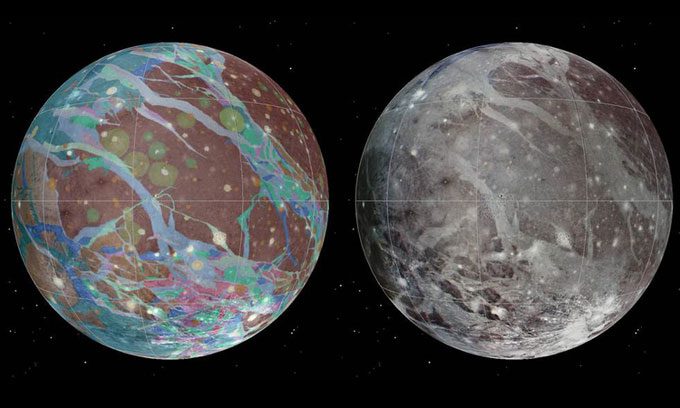The Juno spacecraft is set to fly close to Jupiter’s moon Ganymede at a speed of 68,400 km/h in the coming days to collect data.
The Juno spacecraft (NASA) will fly near Ganymede, the largest moon in the Solar System, on June 7. With a diameter of over 5,260 km, Ganymede is even larger than Mercury.
Juno has been observing Jupiter and its moons since July 2016. During the upcoming approach to Ganymede, the spacecraft will come within 1,038 km of the moon’s surface. This will be the first spacecraft to approach Ganymede in over 20 years, with the last close encounter being conducted by the Galileo spacecraft in May 2000.

Color composite map (left) and geological map (right) of Ganymede, created from images taken by the Voyager and Galileo spacecraft. (Image: USGS Planetary Geoscience Center/Wheaton/NASA/JPL-Caltech).
The camera on Juno will take images of Ganymede while other instruments will collect data to help scientists better understand the composition of this moon, including its icy crust. “Juno is equipped with many sensitive instruments that can observe Ganymede in unprecedented ways,” said Scott Bolton, a researcher at the Southwest Research Institute in San Antonio.
Ganymede is named after a cupbearer to the ancient Greek gods. Not only is it the largest natural satellite in the Solar System, but it is also the only moon known to have a magnetic field. This leads to auroras appearing around its north and south poles.
Ganymede has an iron core covered by a rocky layer, topped by a thick ice crust. There may be an ocean beneath the surface of this moon. Astronomers also detected traces of a thin oxygen atmosphere in 1996 using the Hubble Space Telescope, but this atmosphere is too thin to support life. The surface of Ganymede features scattered bright regions that resemble scars, indicating that this celestial body has undergone significant changes.
On June 7, Juno will use three cameras, including a navigation camera, to observe as much as possible, including high-energy radiation around Ganymede. The approach will happen very quickly, leaving little time to take many pictures. However, the data collected during this flyby can be compared with previous data sent back by the Voyager and Galileo missions.
“On Monday, Juno will fly by Ganymede at a speed of about 68,400 km/h. Less than 24 hours later, the spacecraft will continue its 33rd approach to Jupiter, flying through the cloud tops of the planet at a speed of 208,800 km/h. It will be a spectacular flyby,” shared Matt Johnson, Juno mission manager at NASA’s Jet Propulsion Laboratory (JPL).




















































